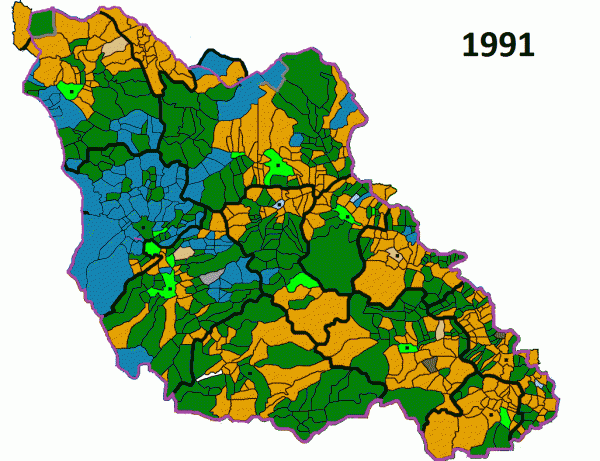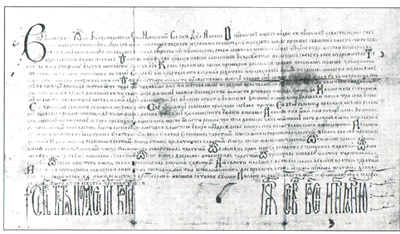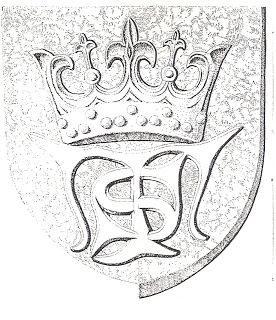|
Kreševo
Kreševo ( sr-cyrl, Крешево, ) is a town and municipality located in Central Bosnia Canton of the Federation of Bosnia and Herzegovina, an entity of Bosnia and Herzegovina. Kreševo is a mountainous town, located in a narrow valley of the Kreševka river, under the slopes of Mount Bitovnje. An old Franciscan monastery of St. Catharine is located in the town's outskirts. History Antique period The area of Kreševo was inhabited since the Neolithic period. Various material remains are indicating that a life in Kreševo was intensified during the Roman Empire, when the municipality was part of the Roman province of Illyricum (Roman province), Illyrcicum, as well as during the Migration Period. Reason for this are the subsoil assets of the Kreševo Municipality area, where gold, silver, copper, iron and mercury where exploited. A number of the Roman aqueducts can be found on the area of the Kreševo Municipality, as well as remains of the Roman settlement near the village of ... [...More Info...] [...Related Items...] OR: [Wikipedia] [Google] [Baidu] |
Central Bosnia Canton
The Central Bosnia Canton ( bs, Srednjobosanski kanton/Средњобосански кантон, hr, Županija Središnja Bosna) is one of 10 cantons of the Federation of Bosnia and Herzegovina in Bosnia and Herzegovina. The most populous settlement in the region is Bugojno, followed by Travnik and Novi Travnik. Geography It is located in the center of the country, to the west of Sarajevo. The center of canton government is Travnik. Municipalities The canton is split into the municipalities of Bugojno, Busovača, Dobretići, Donji Vakuf, Fojnica, Gornji Vakuf-Uskoplje, Jajce, Kiseljak, Kreševo, Novi Travnik, Travnik, Vitez. The region reports a GDP equitable with the average of Bosnia and Herzegovina more broadly. The region has historically benefitted from agriculture and trade, as well as mineral deposits. The Central Bosnia Canton is the fifth largest of ten and its share of the national population is slightly below average. In April of 2022, the United Nations' Off ... [...More Info...] [...Related Items...] OR: [Wikipedia] [Google] [Baidu] |
Kingdom Of Bosnia
The Kingdom of Bosnia ( sh, Kraljevina Bosna / Краљевина Босна), or Bosnian Kingdom (''Bosansko kraljevstvo'' / Босанско краљевство), was a medieval kingdom that lasted for nearly a century, from 1377 to 1463, and evolved out of the Banate of Bosnia, which itself lasted since at least 1154. Although Hungarian kings viewed Bosnia as under their sovereignty during this time, Bosnian sovereignty and independence in conducting its affairs is nevertheless undeniable. King Tvrtko I (r. 1353–91) acquired portions of western Serbia and most of the Adriatic coast south of the Neretva River. During the late part of his reign, Bosnia became one of the strongest states in the Balkan Peninsula. However, feudal fragmentation remained important in Bosnia and the Bosnian nobility held significant power, exercising it at the Stanak meetings where members deliberated on matters such as election of the new king or queen and coronations, foreign policy, sale o ... [...More Info...] [...Related Items...] OR: [Wikipedia] [Google] [Baidu] |
Visoko
Visoko ( sr-cyrl, Високо, ) is a city located in the Zenica-Doboj Canton of the Federation of Bosnia and Herzegovina, an entity of Bosnia and Herzegovina. As of 2013, the municipality had a population of 39,938 inhabitants with 11,205 living in Visoko town. Located between Zenica and Sarajevo, Visoko lies where the river Fojnica joins the Bosna. The Visoko region has evidence of long continuous occupation, with the first traces of life dating back to the 5th millennium BC. Archaeological excavations of Okolište have found one of the biggest neolithic settlements of the Butmir culture in southeastern Europe. It was an early political and commercial center of the Bosnian medieval state, and the site where the first Bosnian king Tvrtko I was crowned. The Old town Visoki, located on Visočica hill, was a politically important fortress, and its inner bailey Podvisoki was an early example of a Bosnian medieval urban area.Pavao Anđelić, Srednji vijek – Doba stare bosan ... [...More Info...] [...Related Items...] OR: [Wikipedia] [Google] [Baidu] |
Sarajevo
Sarajevo ( ; cyrl, Сарајево, ; ''see Names of European cities in different languages (Q–T)#S, names in other languages'') is the Capital city, capital and largest city of Bosnia and Herzegovina, with a population of 275,524 in its administrative limits. The Sarajevo metropolitan area including Sarajevo Canton, Istočno Sarajevo, East Sarajevo and nearby municipalities is home to 555,210 inhabitants. Located within the greater Sarajevo valley of Bosnia (region), Bosnia, it is surrounded by the Dinaric Alps and situated along the Miljacka River in the heart of the Balkans, a region of Southern Europe. Sarajevo is the political, financial, social and cultural center of Bosnia and Herzegovina and a prominent center of culture in the Balkans. It exerts region-wide influence in entertainment, media, fashion and the arts. Due to its long history of religious and cultural diversity, Sarajevo is sometimes called the "Jerusalem of Europe" or "Jerusalem of the Balkans". It is o ... [...More Info...] [...Related Items...] OR: [Wikipedia] [Google] [Baidu] |
Bosnia And Herzegovina
Bosnia and Herzegovina ( sh, / , ), abbreviated BiH () or B&H, sometimes called Bosnia–Herzegovina and often known informally as Bosnia, is a country at the crossroads of south and southeast Europe, located in the Balkans. Bosnia and Herzegovina borders Serbia to the east, Montenegro to the southeast, and Croatia to the north and southwest. In the south it has a narrow coast on the Adriatic Sea within the Mediterranean, which is about long and surrounds the town of Neum. Bosnia, which is the inland region of the country, has a moderate continental climate with hot summers and cold, snowy winters. In the central and eastern regions of the country, the geography is mountainous, in the northwest it is moderately hilly, and in the northeast it is predominantly flat. Herzegovina, which is the smaller, southern region of the country, has a Mediterranean climate and is mostly mountainous. Sarajevo is the capital and the largest city of the country followed by Banja Luka, Tu ... [...More Info...] [...Related Items...] OR: [Wikipedia] [Google] [Baidu] |
Municipalities Of Bosnia And Herzegovina
In Bosnia and Herzegovina, the smallest administrative unit is the municipality ("''opština''/општина" or "''općina''/опћина" in the official languages and scripts of the country). Prior to the 1992–95 Bosnian War there were 109 municipalities in what was then Socialist Republic of Bosnia and Herzegovina. Ten of these formed the area of the capital Sarajevo. After the war, the number of municipalities was increased to 143, grouped in the following way: *79 municipalities constitute the Federation of Bosnia and Herzegovina (FBiH), which comprises 51% of the country's total territory. The municipalities within the federation are grouped into ten cantons. *64 municipalities constitute the Republika Srpska (RS), which comprises 49% of the country's total territory. In addition, Brčko District does not belong to either entity and is governed as a condominium of both FBiH and RS entities. The district corresponds to the pre-war Brčko municipality. Although technica ... [...More Info...] [...Related Items...] OR: [Wikipedia] [Google] [Baidu] |
Federation Of Bosnia And Herzegovina
The Federation of Bosnia and Herzegovina is one of the two Political divisions of Bosnia and Herzegovina, entities within the State of Bosnia and Herzegovina, the other being Republika Srpska. The Federation of Bosnia and Herzegovina consists of 10 autonomous Cantons of the Federation of Bosnia and Herzegovina, cantons with their own governments and legislatures. The Federation was created by the 1994 Washington Agreement (1994), Washington Agreement, which ended the Croat–Bosniak War within the Bosnian War, and established a constituent assembly that continued its work until October 1996. The Federation has a Sarajevo, capital, Government of Bosnia and Herzegovina, government, president, parliament, customs and police departments and two postal systems. It occupies about half of the land of Bosnia and Herzegovina. From 1996 until 2005 it had its own army, the Army of the Federation of Bosnia and Herzegovina, later merged in the Armed Forces of Bosnia and Herzegovina. The ca ... [...More Info...] [...Related Items...] OR: [Wikipedia] [Google] [Baidu] |
Bosnia (region)
Bosnia ( sh-Latn-Cyrl, separator=" / ", Bosna, Босна, ) is the northern region of Bosnia and Herzegovina, encompassing roughly 81% of the country; the other region, the southern part, is Herzegovina. The two regions have formed a geopolitical entity since medieval times, and the name "Bosnia" commonly occurs in historical and geopolitical senses as generally referring to both regions (Bosnia and Herzegovina). The official use of the combined name started only in the late period of Ottoman rule. Geography Bosnia lies mainly in the Dinaric Alps, ranging to the southern borders of the Pannonian plain, with the rivers Sava and Drina marking its northern and eastern borders. The area of Bosnia comprises approximately 39,021 km2, and makes up about 80% of the territory of the present-day state of Bosnia and Herzegovina. There are no true borders between the region of Bosnia and the region of Herzegovina. Unofficially, Herzegovina is south of the mountain Ivan planina. Acco ... [...More Info...] [...Related Items...] OR: [Wikipedia] [Google] [Baidu] |
Saxons
The Saxons ( la, Saxones, german: Sachsen, ang, Seaxan, osx, Sahson, nds, Sassen, nl, Saksen) were a group of Germanic * * * * peoples whose name was given in the early Middle Ages to a large country (Old Saxony, la, Saxonia) near the North Sea coast of northern Germania, in what is now Germany. In the late Roman Empire, the name was used to refer to Germanic coastal raiders, and as a name similar to the later "Viking". Their origins are believed to be in or near the German North Sea coast where they appear later, in Carolingian times. In Merovingian times, continental Saxons had been associated with the activity and settlements on the coast of what later became Normandy. Their precise origins are uncertain, and they are sometimes described as fighting inland, coming into conflict with the Franks and Thuringians. There is possibly a single classical reference to a smaller homeland of an early Saxon tribe, but its interpretation is disputed. According to this proposal, the S ... [...More Info...] [...Related Items...] OR: [Wikipedia] [Google] [Baidu] |
Romanesque Architecture
Romanesque architecture is an architectural style of medieval Europe characterized by semi-circular arches. There is no consensus for the beginning date of the Romanesque style, with proposals ranging from the 6th to the 11th century, this later date being the most commonly held. In the 12th century it developed into the Gothic style, marked by pointed arches. Examples of Romanesque architecture can be found across the continent, making it the first pan-European architectural style since Imperial Roman architecture. The Romanesque style in England and Sicily is traditionally referred to as Norman architecture. Combining features of ancient Roman and Byzantine buildings and other local traditions, Romanesque architecture is known by its massive quality, thick walls, round arches, sturdy pillars, barrel vaults, large towers and decorative arcading. Each building has clearly defined forms, frequently of very regular, symmetrical plan; the overall appearance is one of simplic ... [...More Info...] [...Related Items...] OR: [Wikipedia] [Google] [Baidu] |
Stephen Thomas Of Bosnia
Stephen Thomas ( sh-Latn-Cyrl, separator=/, Stefan Tomaš, Стефан Томаш, sh-Latn-Cyrl, separator=/, label=none, Stjepan Tomaš, Стјепан Томаш; 1411 – July 1461), a member of the House of Kotromanić, reigned from 1443 until his death as the penultimate king of Bosnia. An illegitimate son of King Ostoja, Thomas succeeded King Tvrtko II, but his accession was not recognized by the leading magnate of the Kingdom of Bosnia, Stjepan Vukčić Kosača. The two engaged in a civil war which ended when the King repudiated his wife, Vojača, and married the insubordinate nobleman's daughter, Catherine. Thomas and his second wife, both raised in the Bosnian Church tradition, converted to Roman Catholicism and sponsored construction of churches and monasteries throughout the kingdom. Throughout his reign, Thomas waged a war with the Serbian Despotate over the lucrative mining town of Srebrenica and its surroundings, in addition to (or in conjunction with) multip ... [...More Info...] [...Related Items...] OR: [Wikipedia] [Google] [Baidu] |
Republic Of Ragusa
hr, Sloboda se ne prodaje za sve zlato svijeta it, La libertà non si vende nemmeno per tutto l'oro del mondo"Liberty is not sold for all the gold in the world" , population_estimate = 90 000 in the XVI Century , currency = Ragusa perpera and others , common_languages = , title_leader = Rector as Head of state , leader1 = Nikša Sorgo , year_leader1 = 1358 , leader2 = Sabo Giorgi , year_leader2 = 1807-1808 , today = Croatia Bosnia and Herzegovina Montenegro , footnotes = A Romance language similar to both Italian and Romanian. While present in the region even before the establishment of the Republic, Croatian, also referred to as ''Slavic'' or ''Illyrian'' at the time, had not become widely spoken until late 15th century. The Republic of Ragusa ( dlm, Republica de Ragusa; la, Respublica Ragusina; it, Repubblica di Ragusa; hr, Dubrovačka Republika ... [...More Info...] [...Related Items...] OR: [Wikipedia] [Google] [Baidu] |









.jpg)